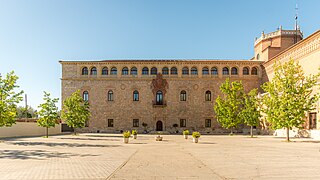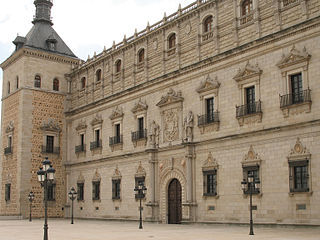
At the end of the 16th century, the Francisco de los Cobos Palace was enlarged and refurbished and was sold to the King Philip III.
Luis de Vega (? - 10 November 1562) was a 16th-century Spanish architect appointed royal architect of Charles I.

Luis de Vega (? - 10 November 1562) was a 16th-century Spanish architect appointed royal architect of Charles I.
In 1518 to find Luis de Vega settled in Torrelaguna to take care of the construction of some houses owned by the university. By 1520 he had moved to Madrid. In the mid-twenties he did work in Valladolid for Don Francisco de los Cobos y Molina, the imperial secretary. [1]
In 1531 he became a teacher at the Colegio Mayor de San Ildefonso, a position he held until his death. That same year Cobos sent him to Úbeda, where Cobos had commissioned some building work. In 1537 he managed the administration regarding the facade work on the college by Rodrigo Gil de Hontañón. [1]
He renovated the old Alcazar of Madrid. Construction started in 1537. [2] : 7 Also is 1537, Vega built a manor house, the Palacio de Dueñas, in Medina del Campo for Dr. Beltrán, friend of Cobos. In December 1537, Vega and Alonso de Covarrubias were appointed to be in charge of the expansion, reconstruction and reform of the fortresses of Madrid, Toledo and Seville, with the obligation that each of the masters reside alternately for six months in them.
In 1538, the Emperor sent Vega to Madrid to review the plans for the palace Charles was having built at the Alhambra. While there he directed the construction of the chapel of the bishop of Calahorra, Don Alonso de Castilla Zúniga in the Madrid convent of Santo Domingo, including a new porch. [1]
In 1540 he designed the upper story of the "Patio de las Doncellas" (Courtyard of the Maidens) in the Alcázar of Seville. The addition was designed in the style of the Italian Renaissance although Vega did include both Renaissance and mudéjar plaster work in the decorations. In 1542, he transformed the pavilion on mount El Pardo, into what is now the Royal Palace of El Pardo. Vega transformed the small hunting lodge into a traditional alcázar with a moat. [3] In 1545, he designed a plan for the Hospital de la Sangre in Seville.
With his nephew, the architect Gaspar de Vega, he worked on the vanished Palace of Valsain. They also designed the plans for the Convento de San Felipe el Real in Madrid (1545). In 1547 he designed the Torre de la Parada, a hunting lodge near the Royal Palace of El Pardo. In 1550 Vega was in Aranjuez overseeing the rebuilding of the dam that the river had carried away. In July he looked to the repairs in the Forest of Segovia hunting ground.
He also worked on a number of manor houses including the Francisco de los Cobos Palace in Valladolid (the Valladolid Royal Palace).
Luis de Vega died in Madrid on 10 November 1562.

The Spanish Golden Age was a period that coincided with the political rise of the Spanish Empire under the Catholic Monarchs of Spain and the Spanish Habsburgs. This era saw a flourishing of literature and the arts in Spain. The most significant patron of Spanish art and culture during this time was King Philip II (1556–1598). However, the period is more broadly associated with the reigns of Isabella I, Ferdinand II, Charles V, Philip II, Philip III, and Philip IV, when Spain was at the peak of its power and influence in Europe and the world.

The Royal Palace of Madrid is the official residence of the Spanish royal family at the city of Madrid, although now used only for state ceremonies. The palace has 135,000 m2 (1,450,000 sq ft) of floor space and contains 3,418 rooms. It is the largest royal palace in Europe.

The Royal Sites are a set of palaces, monasteries, and convents built for and under the patronage of the Spanish monarchy. They are administered by Patrimonio Nacional (National Heritage), a Spanish state agency; most are open to the public, at least in part, except when they are needed for state or official events.

Úbeda is a municipality of Spain located in the province of Jaén, Andalusia.

The Zarzuela Palace is the residence and working offices of the reigning monarch of Spain, although the official residence of the Spanish royal family is the Royal Palace of Madrid. The Zarzuela Palace is on the outskirts of Madrid, near the Royal Palace of El Pardo, which accommodates visiting heads of state. The palace is owned by the Spanish government and administered by a state agency named Patrimonio Nacional.

Juan de Herrera was a Spanish architect, mathematician and geometrician.

The Alcázar of Seville, officially called Royal Alcázar of Seville, is a historic royal palace in Seville, Spain. It was formerly the site of the Islamic-era citadel of the city, begun in the 10th century and then developed into a larger palace complex by the Abbadid dynasty and the Almohads. After the Castilian conquest of the city in 1248, the site was progressively rebuilt and replaced by new palaces and gardens. Among the most important of these is a richly-decorated Mudéjar-style palace built by Pedro I during the 1360s.

The Royal Palace of El Pardo is one of the official residences of the Spanish royal family and one of the oldest, being used by the Spanish monarchs since Henry III of Castile in the 15th century. It is administered by the Patrimonio Nacional agency and it currently serves as a state guest house.

The Royal Palace of Valladolid was the official residence of the kings of Spain during the period in which the royal court had its seat in Valladolid between 1601 and 1606, and a temporary residence of the Spanish monarchs from Charles I to Isabella II, as well as of Napoleon during the Peninsular War. Currently it is the headquarters of the 4th General Sub-inspection of the Spanish Army.

Spanish Renaissance architecture was that style of Renaissance architecture in the last decades of the 15th century. Renaissance evolved firstly in Florence and then Rome and other parts of the Italian Peninsula as the result of Renaissance humanism and a revived interest in Classical architecture. In Spain, the Renaissance began to be grafted to Gothic forms as mathematicians and engineers rediscovered building as one of the technological sciences. In the time of King Felipe II (1556–1589), the Renaissance influence expanded throughout the territory thanks to the dissemination of architectural treatises.

The Royal Alcázar of Madrid was a fortress located at the site of today's Royal Palace of Madrid, Madrid, Spain. The structure was originally built in the second half of the ninth century by the Muslims, then extended and enlarged over the centuries, particularly after 1560. It was at this time that the fortress was converted into a royal palace, and Madrid became the capital of the Spanish Empire. Despite being a palace, the great building kept its original Arabic title of Alcázar.
Francisco de Mora (c.1553–1610) was a Spanish Renaissance architect.

The Torre de la Parada is a former hunting lodge that was located in present-day Monte de El Pardo in Fuencarral-El Pardo, near the Royal Palace of El Pardo, some way outside Madrid in the Sierra de Guadarrama. It was mostly destroyed by fire when taken in 1714 by Austrian troops in the War of Spanish Succession, though the ruins remain.

Purism is an initial phase of Renaissance architecture in Spain, which took place between 1530 and 1560, after Isabelline Gothic and prior to the Herrerian architecture in the last third of the 16th century. The name "Prince Philip" refers to the period in which Philip II of Spain had not yet received the inheritance of the Spanish Monarchy by abdication of his father, the Emperor Charles V (1556). The name "Serlian" is due to the influential architect and treatise Sebastiano Serlio.

Juan Pardo de Tavera was a Spanish Roman Catholic cardinal who was Archbishop of Toledo and Primate of Spain (1534–1545) and Grand Inquisitor of Spain (1539–1545). He had previously been Archbishop of Santiago de Compostela (1524–1534), Bishop of Osma (1523–1524), Bishop of Ciudad Rodrigo (1514–1523) and President of the Royal Council (1524-1539).

The Archiepiscopal Palace of Alcalá de Henares is a palace located in Alcalá de Henares, in the Community of Madrid, Spain. It is now home to the Diocese of Alcalá de Henares. It is located in the Plaza del Palacio and this form part of the monumental set declared World Heritage Site by UNESCO.

Alonso de Covarrubias was a Spanish architect and sculptor of the Renaissance, active mainly in Toledo.

The Project of Filippo Juvarra for the Royal Palace of Madrid was the first project for the Royal Palace of Madrid.

The Palacio de la Ribera was the summer residence of Philip III in Valladolid. It was built in the 17th century (1602-1605) as part of a process of urban transformation upon the establishment of the Spanish Court in Valladolid between 1601 and 1606. The palace was situated at the Huerta del Rey neighborhood, located across the Parque de las Moreras on the right bank of the Pisuerga river. The palace grounds extended from the Puente Mayor to Ribera de Don Periáñez del Corral and delimited at both sides by the Pisuerga river and the Camino del Monasterio del Prado. The palace was gradually abandoned until it became part of the destroyed cultural heritage of Valladolid in 1761. Some ruins of the building are still preserved.

The Parador de Úbeda, also known as the Palacio del Deán Ortega, the Palacio del Marqués del Donadío and the Parador del Condestable Dávalos is a four-star Parador hotel located in the oldest part of the city of Úbeda, in the province of Jaén, in the eastern part of the autonomous community of Andalucía, Spain. It is situated in the monumental Plaza de Vázquez de Molina, and surrounded by other imposing Renaissance buildings. It was converted into a hotel from one of the most important Renacimiento español palaces in the city.